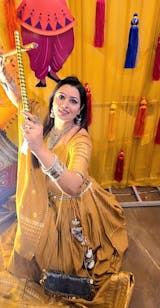The Salwar Kameez, a quintessential Indian ethnic attire, is a canvas for showcasing the intricate artistry of traditional Indian embroidery. A traditional ensemble consisting of a long tunic (kameez), loose-fitting trousers (salwar), and a matching scarf or shawl (dupatta) provides an ideal setting for the embroidery techniques that have been passed down through generations. Let's examine how traditional Indian embroidery transforms the Salwar Kameez into a masterpiece of craftsmanship and cultural expression as we embark on a journey through the rich world of traditional Indian embroidery.
Embroidery Techniques:
Embroidery in India is a diverse and vibrant art form that differs from region to region in terms of techniques, stitches, and motifs. Traditional Indian embroidery techniques have been perfected through the centuries by artisans of different regions, passing down them from generation to generation. Applied to the Salwar Kameez, these techniques elevate the garment beyond mere clothing, turning it into a wearable piece of art when applied.

This embroidery is characterized by its vibrant threadwork, which originated in Punjab. Phulkari translates to "flower work." True to its name, this embroidery is often embellished with colourful and bold floral patterns. In combination with a Salwar Kameez, Phulkari adds energy and playfulness to the outfit, making it an excellent choice for festivals.

A delicate and intricate form of embroidery, Chikankari originates from Lucknow and is traditionally done with white thread on light pastel fabrics. Chikankari combines beauty and elegance to create a Salwar Kameez that is ethereal and timeless. Various motifs are included in this embroidery, ranging from florals to paisleys, and the fine stitches create an exquisite texture that reflects the embroidery's elegance.

This form of metal embroidery originated in Persia and was incorporated into Indian couture through zardozi. Metallic threads, sequins, and beads are used to create elaborate patterns in this opulent embroidery. Combined with the Salwar Kameez, Zardozi provides regal grandeur, making it a popular choice for weddings and other formal occasions.

Kantha embroidery is a traditional Bengali embroidery that utilizes simple running stitches to create intricate patterns. The work depicts scenes from everyday life, nature, and mythology, and when incorporated into a Salwar Kameez, the embroidery tells a story, adding a unique touch to the garment as well as a personal touch.

Shisha embroidery, A mirror work design, involves incorporating small mirrors into the fabric with vibrant threads. With this reflective embellishment, the Salwar Kameez adds a playful element and catches the light, creating a mesmerizing effect. A popular traditional textile art from Gujarat, mirror work is widely associated with its rich textile heritage.
Cultural Significance:
Salwar Kameez embroidery is not simply an embellishment; it represents the cultural heritage, traditions, and stories of the regions where these techniques were developed. It is evident from every stitch that the artisans were able to create these intricate patterns with skill and workmanship. Furthermore, the type of embroidery commonly signifies the type of celebration, formal gathering, or cultural event for which the Salwar Kameez is intended.
Versatility and Modern Trends:
Traditional Indian embroidery techniques have a long history but continue evolving to meet contemporary needs. Designers often experiment with fusion styles by combining traditional techniques with contemporary styles. Salwar Kameez remains a versatile garment, appealing to a wide range of fashion sensibilities as a result of this infusion of innovation.
Conclusion:
A Salwar Kameez from Zeel Clothing is a perfect canvas for traditional Indian embroidery with its three pieces. It is important to note that each embroidery technique adds a unique character to the garment, whether the bold and vibrant Phulkari, the delicate Chikankari, the opulent Zardozi, or the storytelling Kantha. The Salwar Kameez remains a symbol of sartorial elegance and cultural identity, and traditional Indian embroidery performs a vital role in preserving the rich textile heritage of India by maintaining the integrity of this timeless ensemble.









